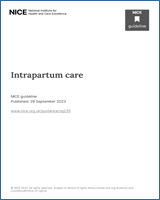From: Intrapartum care

Intrapartum care.
NICE Clinical Guidelines, No. 235.
London: National Institute for Health and Care Excellence (NICE); 2023 Sep 29.
Copyright © NICE 2023.
NCBI Bookshelf. A service of the National Library of Medicine, National Institutes of Health.